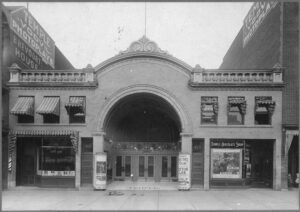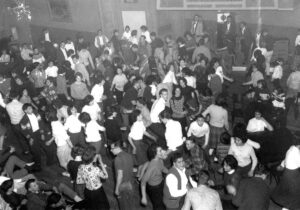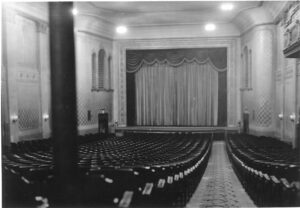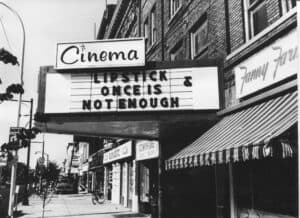Temple Theatre and Regent Theater
By Becky Chapin, Archivist
Sometimes it feels like other theaters in town take a back seat to the Smith Opera House, historically speaking. Granted the Smith is the one that has been open the longest but Geneva did have a few other theaters . Two of the other longest running theaters were the Temple Theatre, 409-417 Exchange Street, and the Regent Theater, 495-501 Exchange Street. It’s quite impressive that these three theaters were operating within blocks of each other despite serving the same entertainment purposes.

Exterior of the Temple Theatre, circa 1915
The Temple Theatre was opened in 1912 by Frank Pierce and Jacob Nagel and was one of the leading theatres in the area for a number of years for vaudeville productions and pictures. The architect was Leon Lempert & Son of Rochester, theatrical architects who had designed the Smith and would go on to design the Regent Theatre as well.
On opening night in January, its vaudeville stage had not been finished but there were three thousand admissions for the moving pictures. The popularity of its shows brought enough crowds of people in the evenings during the first few months that the police were brought in to ‘preserve order.’ The Temple could house close to 1,000 people with a large balcony and a fireproof area to house the ‘picture apparatus and films.’
The building also housed offices and shops which opened at the same time like the Temple Chocolate Shop, a dentist office, and dry goods store. The stage was completed in time for the following year’s season and the Temple Orchestra provided live music for the pictures and performances. In April 1920, the LG Brady Amusement Enterprises, Inc. was formed with the goal of purchasing the theatre. They assumed control in September but within a year the Brady Company would reorganize as the Temple Photoplay Company and LG Brady had moved to the Smith.
The Temple Theater attracted many audiences for its offerings and by 1922, it had requested from the Council the ability to show pictures on Sundays as part of Reverend Alexander Thompson’s evening sermon series (of North Presbyterian Church). The series was a success and attracted large crowds for Thompson’s sermons, singing, and picture sermons shown on the big screen. The profits were donated to various city organizations to help those in need and during the three month series over $1,000 was raised. By that time, the services had moved to the Smith.
Schine’s Theater Circuit assumed control of the Temple Theatre in 1925 and would close the theatre in 1931 when Schine’s Geneva Theatre opened. Gerald Fowler, as a Schine employee, was in charge of projection at the Temple Theatre and would also work in its other Geneva theaters. After renovations, Schine’s Temple would reopen in the 1940s to handle the influx of movies goers in the area. Unfortunately, with the closure of the US Naval Base at Sampson, the decline in demand led Schine to sell the theatre in the 1950s.

Inside the night club Teen-Ago-Go, showing teenagers dancing to the rock and roll band seen in the upper right.
In March 1965, Jim Rinaldo opened the Temple Theatre as the teen night club Teen-Ago-Go where teenagers could dance to the house band (usually Bobby D and the Trinidads) while their parents could sit in the balcony. More than 600 teens came on opening night and 300 came on the following night. The club didn’t last long, however, and the building was left vacant and slowly deteriorating. In 1975, the building was demolished after the roof collapsed and its owners couldn’t comply with deadlines for repair work imposed by the city.

Exterior of the Regent Theater after Schine’s reopening.
Shortly after the Temple’s opening, plans for building the Regent Theatre were begun by Edward O’Rielly and Charles Sweeney. On opening day in 1915, its first moving pictures event attracted 2,500 people and many were turned away when it reached capacity. Unlike the Temple, the ownership of the Regent was rarely within the hands of the locals. Its original lease was sold to a Pennsylvania company, Comerford Amusement Co., who mutually broke the lease with the manager after five years. The Biddle Holding Corporation of NYC took up the lease but after just two years it was sold to Associated Theatres Inc. who had also obtained the Smith and Temple theatres in 1922.
In an attempt to gain local control of the theatre, Ontario Theatres Company organized as a unit of Associated Theatres in 1923 which included the operation of the Smith and Regent. They promised to bring the best productions to Geneva as soon as possible instead of having to wait a year for popular screen plays to arrive. Schine’s Theatrical Company purchased the holdings of the president of Associated Theatres in 1924, combining two of the biggest circuits in the area and covered playhouses across the state, including the big three in Geneva.

Inside the Regent Theater looking towards the stage. Renovations were completed before the Smith, but their interiors look similar.
Schine’s Regent Theatre opened in August 1928 after a complete renovation (see the blog on Gerald regarding the union strike of sound technicians at this time). The Regent Orchestra, founded in 1925, continued its performances to accompany the movies; its purpose was to ‘greatly heighten the pleasure of each performance’ and ‘keep harmony with the picture on the screen.’
The Regent would be under Schine’s management until the late 1950s and would be closed until the early 1960s when it reopened as the Cinema Theatre. It would retain this name for a number of years and would later be known as the Geneva Cinema 5 Regent Theater once Zurich Cinemas purchased it. The theater closed in 2005 and housed a church congregation for some time.

Exterior of the Cinema Theatre in the 1970s.
In 2013, KidVenture Dome was opened with the Jones Theatre upstairs before it closed again in 2016. Twisted Rail Brewing Co. repurposed the space and opened in 2019 to feature their beer-making operation along with a tasting area and restaurant. An education center focusing on brewing was built upstairs in the only remaining theater from the building’s days as Cinema 5 Regent Theatre.
Historic Geneva tells the stories of Geneva, New York. Discover these stories online and in person through the Geneva History Museum, Rose Hill Mansion, and Johnston House.

Quite a story. Thank you Becky for doing all that research.
I very much enjoy your blogs. They are always interesting and informative. Thanks, Becky!